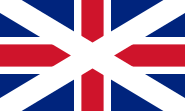
| |
| Use | Civil and state flag |
|---|---|
| Proportion | 3:5[1] |
| Adopted | 16th century |
| Design | Argent, a cross gules, i.e. a red cross on a white background |
The Flag of England is the St George's Cross (heraldic blazon: Argent, a cross gules). The red cross appeared as an emblem of England during the Middle Ages and the Crusades (although originally a white cross on red background) and is one of the earliest known emblems representing England.[2] It also represents the official arms of the Most Noble Order of the Garter, and it achieved status as the national flag of England during the sixteenth century.[1]
Saint George became the patron saint of England in the thirteenth century, and the legend of Saint George slaying a dragon dates from the twelfth century.
Origins
At the beginning of the Crusades the Pope decided English crusaders would be distinguished by wearing a white cross on red, and French crusaders a red cross on white (Italian knights were allocated a yellow cross on a white background),[3] English knights soon decided to claim "their" cross of red on white, like the French. In January 1188, in a meeting between Henry II of England and Philip II of France, the two rivals agreed to exchange flags (France later changed its new white cross on red for a white cross on a dark blue flag).[4] Some French knights carried on using the red cross however, and as English knights wore this pattern as well, the red cross on white became the typical crusader symbol regardless of nationality.[5]

Saint George seen in the act of slaying the dragon. He is depicted wearing a surcoat displaying the St George's Cross
The flag appeared during the Middle Ages. The St George's Cross was used as an emblem (but not as a flag) of England was in a roll of account relating to the Welsh War of 1275.[1] The English royalist forces at the Battle of Evesham in 1265 used a red cross on their uniforms, to distinguish themselves from the white crosses used by the rebel barons at the Battle of Lewes a year earlier.
The use of a red cross on a white background was a symbol of St. George in the Middle Ages. This is seen, for example, in the flag of Georgia, another country with Saint George as their patron saint. St George's cross may not have achieved the full status of national flag until the sixteenth century, when all other saints' banners were abandoned during the Reformation. Thereafter it became recognised as the flag of England and Wales. The earliest record of St George's Cross at sea, as an English flag in conjunction with royal banners but no other saintly flags, was 1545.[1]
Despite the fact that the King of France in 1188 had recognised the St George's Cross as an English symbol, some historians believe that the St George's Cross was adopted from the flag of Genoa, which originates as far back as 1096. On the origins of the flag the Duke of Kent remarked:
"The St. George's flag, a red cross on a white field, was adopted by England and the City of London in 1190 for their ships entering the Mediterranean to benefit from the protection of the Genoese fleet. The English Monarch paid an annual tribute to the Doge of Genoa for this privilege."[6]
HRH The Duke of Kent
Flying the flag
Sporting events

Flag flying on Leeds Town Hall.

English Rugby team supporter waving the English flag in the streets of Nantes, France in 2007.
The flag is also seen during other sporting events in which England competes, for example during England Cricket matches (the Cricket World Cup and The Ashes), during Rugby Union matches[7] and in football.[8] It is also used in icons on the Internet and on the TV screen to represent teams and players from England.
Before 1996, most of the flags waved by supporters were Union Flags (it is now arguable that this situation has now reversed).[9]
Church of England
Churches belonging to the Church of England (unless for special reasons another flag is flown by custom) may fly St George's Cross. The correct way (since an order from the Earl Marshal in 1938) is for the church to fly the St George's cross, with the arms of the diocese in the left-hand upper corner of the flag.[10]
City of London

Flag of the City of London

The White Ensign of the United Kingdom, consisting of the flag of Saint George, defaced with the Union Flag in the first quarter
The flag of the City of London is based on the English flag, having a centred St George's Cross on a white background, with a red sword in the upper hoist canton (the top left quarter). The sword is believed to represent the sword that beheaded Saint Paul who is the patron saint of the city.[11]
The flag used by the British Royal Navy (the White Ensign) is also based on the flag of England, consisting of the St George's Cross and a Union Flag in the canton. In addition to the United Kingdom, several countries in the Commonwealth of Nations also have variants of the White Ensign with their own national flags in the canton, with the St George's Cross sometimes being replaced by a naval badge.[12]
Perceived association with the far right
For many years, the Cross of St George had come to be associated by some with far-right political groups such as the British National Party and the National Front. Many people consider this association to be unjustified as it is the Union Flag which is predominantly used by groups such as the British National Party.[13] The Cross of St George is often used by far-right groups, usually alongside the individual flags of Wales, Scotland and Northern Ireland. However, the frequent use of the English flag by sports supporters and other groups has gone some way to disassociate the flag from any lingering association with the far-right and the Cross of St George is now frequently flown throughout the country. Despite this, displaying the flag remains controversial to a minority of people in England[14]
Some minorities living in England have stated that they still view the flag with suspicion: during a poll of readers of New Nation, "most black people interviewed said they felt alienated by the flag of St George and still associated it with the BNP".[14] However, many young, non-white people do display the flag, particularly for sporting events .[15]
Incorporation into the Union Flag

The Flag of England flying alongside the Flag of the United Kingdom.
The Flag of England is one of the key components of the Union Flag. The Union Flag has been used in a variety of forms since the proclamation by Orders in Council 1606,[16][17] when the Flag of Scotland and the Flag of England were first merged to symbolise the Union of the Crowns.[18] (The Union of the Crowns having occurred in 1603). In Scotland, and in particular on Scottish vessels at sea, historical evidence suggests that a separate design of Union Flag was flown to that used in England.[19] However, following the Acts of Union of 1707, which united the Kingdom of Scotland and the Kingdom of England to become the Kingdom of Great Britain, the 'English' version of the Union Flag was adopted as the official Flag of Great Britain.[20]
From 1801, in order to symbolise the union of the Kingdom of Great Britain with the Kingdom of Ireland, a new design which included the St Patrick's Cross was adopted for the flag of the United Kingdom of Great Britain and Ireland.[21] The Flag of the United Kingdom, having remained unchanged following the partition of Ireland in 1921 and creation of the Irish Free State and Northern Ireland, continues to be used as the flag of the United Kingdom of Great Britain and Northern Ireland.
Outside England
Due to the spread of the British Empire, the flag of England is currently, and was formerly used on various flags and coats of arms of different countries, states and provinces throughout the territories of the British Empire.
Canada
Channel Islands
Elsewhere
See also
- Royal Banner of England
- Royal coat of arms of England
- List of English flags
- List of British flags
- Saint Patrick's Flag
- Tudor Rose
- Flags of Europe
- St George's Day in England
References
- ^ a b c d England (United Kingdom); Flags of the World; (c.1996 - Present)
- ^ "United Kingdom Flag History". http://www.britishflag.us/united-kingdom-flag-history.htm. Retrieved 11 July 2011.
- ^ Crusader Cross Flags 1188; Flags of the World; (1999 - 2005)
- ^ Prof. J. Prawer, A history of the Latin Kingdom of Jerusalem (Hebrew, 3rd edition, vol. II, pp. 17-18)
- ^ Adventist Media Response and Conversation: Art and the Crusader's Flag
- ^ Franco Bampi. "Benvenuti al Padiglione Britannico!". Francobampi.it. http://www.francobampi.it/liguria/varie/welcome1992.htm#inglese. Retrieved 2010-09-14.
- ^ England Rugby Football Union
- ^ 2010 FIFA World Cup
- ^ "The Saturday Soap Box: We have to make Jerusalem England's national anthem". Daily Mirror. 2005-09-17. Archived from the original on 2006-10-11. http://web.archive.org/web/20061011022931/http://www.billybragg.co.uk/words/words1.php?word_id=34. Retrieved 2006-11-01.
- ^ Church of England - Use of the flag; Flags of the World; 23 October 2008
- ^ City of London, Britishflags.net
- ^ "United Kingdom: history of the British ensigns". Fotw.net. http://www.fotw.net/flags/gb-enshs.html. Retrieved 2010-04-11.
- ^ BNP Logo;
- ^ a b Conn, David; Sour English stereotypes linger amid the flag-waving; The Guardian; 12 July 2006
- ^ Crampton, Robert; Dad, how come rich people don't fly flags and show they're patriotic?; The Times; 21 June 2006
- ^ Fox-Davies, Arthur Charles (1904 [1986]). The Art of Heraldry: An Encyclopaedia of Armory. London: Bloomsbury Books. p. 399. ISBN 0906223342.
- ^ Royal Website
- ^ Flag Institute
- ^ Flags of the World
- ^ Act of Union (Article 1)
- ^ Flags of the World
External links
| |||||||||||||||||||||||||||||||||||||||||
| This page uses content from the English language Wikipedia. The original content was at Flag of England. The list of authors can be seen in the page history. As with this Familypedia wiki, the content of Wikipedia is available under the Creative Commons License. |
































